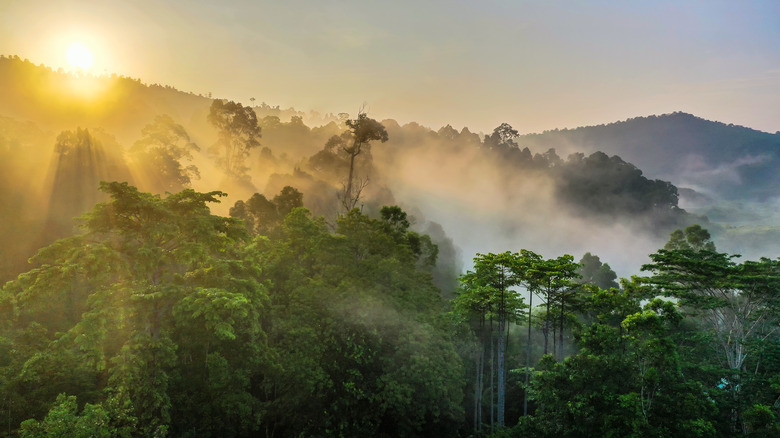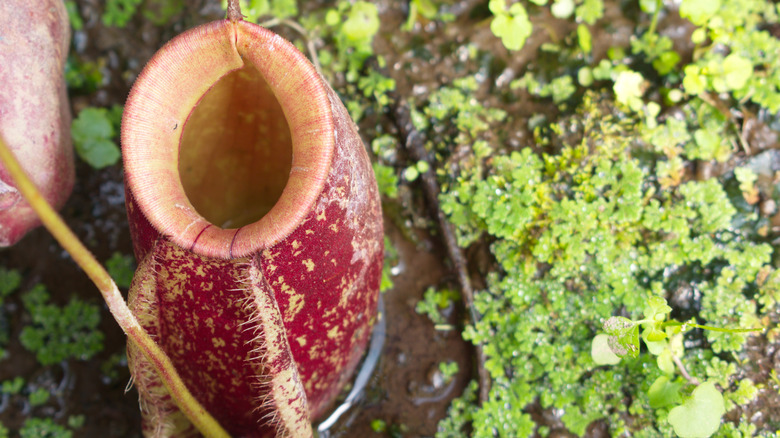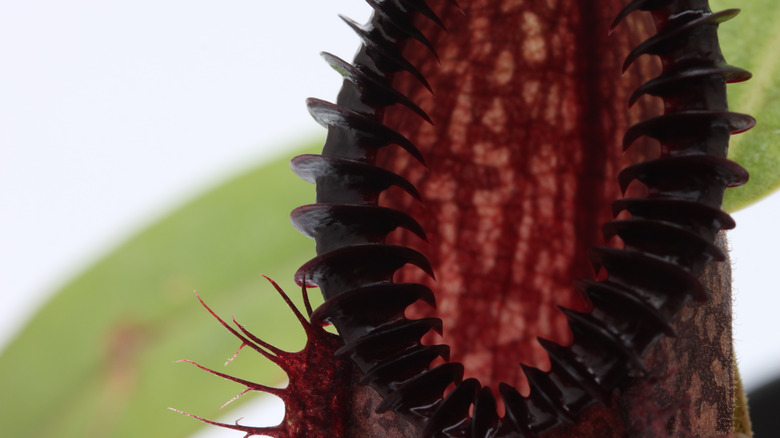This Carnivorous Plant Traps Its Prey Underground
Something sneaky is going on in the jungles of the Malay Archipelago in Southeast Asia. Thanks to a team of scientists from the Czech Republic, a fascinating discovery has taken place on the island of Borneo. Botanists found a new species of carnivorous pitcher plant, which they're calling Nepenthes pudica.
Carnivorous pitcher plants come from a botanical genus referred to as Nepenthes. According to Tom's Carnivores, there are roughly 160 known species within the genus, which are split between two main categories: highlanders and lowlanders. These terms indicate whether they grow in mountainous regions above 3,000 feet or below. Per the World Wildlife Foundation, carnivorous plants like Venus flytraps are known for consuming small insects. What makes pitcher plants stand apart from the rest is that they eat lizards and small rodents. First, they lure prey with sweet-scented nectar. Then, as their victims fall into their large bulbous traps (which resemble water pitchers), the plants close themselves around the insect or animal and release digestive enzymes that slowly break them down. The largest pitchers can grow 5 feet tall and hold up to 3 quarts of liquid.
But Nepenthes pudica is not your standard pitcher plant. In fact, Martin Dančák from Palacky University's Department of Ecology and the Environment is quoted as saying, "We have managed to discover a pitcher plant that behaves completely differently from all other known species" (via Good News Network). Keep reading for the incredible, never-before-seen skill this plant has developed.
How is this pitcher plant different from the rest?
The primary difference between this newly discovered species and the rest of the pitcher plants that make up the Nepenthes genus is that the pudica variety does not stop at catching insects and animals that fall into its traps aboveground. It is the first of its kind to lay traps underground. As far as botanists are aware, Nepenthes pudica is the only plant that has evolved to do this, as reported by the Good News Network.
By expanding its stems into underground cavities and managing to grow pitcher traps in the dark, Nepenthes pudica is able to catch burrowing bugs and animals as they move under the soil. Scientists believe this solution of growing downwards is a response to environmental conditions up on the surface becoming too dry. Moist, fertile soil offers much-needed sustenance, and the plants figured out how to get to it.
According to a 2018 report by The New York Times, jungles in Indonesia are often clear-cut by major commercial industries to plant groves of palm oil trees. These plantations have displaced entire villages of people and caused massive destruction to the fragile ecosystems. Environmentalists are now hoping the discovery of this uniquely evolved carnivorous pitcher plant will shine a light on just how endangered these landscapes are becoming and start to raise global awareness of their importance.
Other carnivorous pitcher plants
Known collectively as Nepenthes, and sometimes called monkey cups, there are many other varieties of carnivorous pitcher plants lurking in faraway jungles around the world, one of which can ingest a rat whole. A rat eaten by a plant in a single swallow! California Carnivores explains that Borneo is the epicenter of Nepenthes' growth, but they are not strictly limited to jungle landscapes, and they certainly don't try to hide. These flesh-eating botanical wonders can be found throughout Southeast Asia, soaking up the sun on hillsides and along ridges. With most of them living at altitudes above 3,000 feet, one thing they do seem to prefer is elevation. Is it cool nights, higher average rainfall, or something more sinister?
Within the highlander category, you can find all sorts of shapes, sizes, and colors. Some, like the Nepenthes veitchii x lowii, are yellow with thin red stripes that almost look like veins along the pitcher. Others, such as the Nepenthes hamata Tambusisi pictured above, are dark reddish-brown and lined with sharp spikes that resemble teeth around the lip of each pitcher.
Lowlanders prefer hotter temperatures and higher humidity. The pitchers of Nepenthes bicalcarata only grow to about 6 inches, but they also grow spurs that look like fangs. If you're trying to get a wasp or yellow jacket problem under control, this guy might be the little helper you never knew you needed. Nepenthes bicalcarata loves to eat them both; stink bugs too!


